Turning a Draft - II
Marcy Petrini
June, 2020
In the May blog we learned out to turn a draft by using an 8-shaft, 4 treadle draft; our turned draft had 4 shafts and 8 treadles, which we reduced to 6 by combining treadles weaving with two feet, since most 4 shaft looms have 6 treadles.
Reducing the number of shafts is just one reason to turn a draft; at the end of the May blog there was a challenge: 3 drafts to turn. The first is to simplify the treadling, the second is to change the structure from a two-shuttle weave to one. The third challenge is a draft on more than 4. All of these result in fabrics with a rotated pattern, which is another reason to turn a draft.
Here is a summary of the steps to turn a draft, which we used last month, and we will use on the 3 challenge drafts:
- Choose a draft with a complete repeat in both threading and treadling; two repeats of each will clarify what happens at the junction of repeats
- Rotate the draft; the treadling becomes the threading and the threading becomes the treadling
- Change the shaft, treadle and treadling step numbers to positions
- The treadling will be on the left side; slide it to the right side, to keep with the convention
- The tie-up is also on the left side; slide it to the right side, above the treadling
- Transpose the tie-up so that all empty positions are filled, and all filled positions are empty
- Change positions back to numbers
- Do the drawdown; it should be identical to the original but rotated.
| ⇐ Threading | Tie - up |
| Drawdown |
T |
Challenge 1: Turning the Draft to Simplify the Treadling
Below is a twill threaded pointed and treadled advancing. When I weave, I like to concentrate on my beat and selvages; thus I prefer a simpler treadling. When I thread, I have to think about only the threading, so a more complicated pattern is acceptable.

Click here for a draft that you can resize as needed
(a PDF will open a new window or in your list of downloaded files)

If I turn it this draft, I will have an advancing threading and a straight treadling:
Here is the draft rotated:
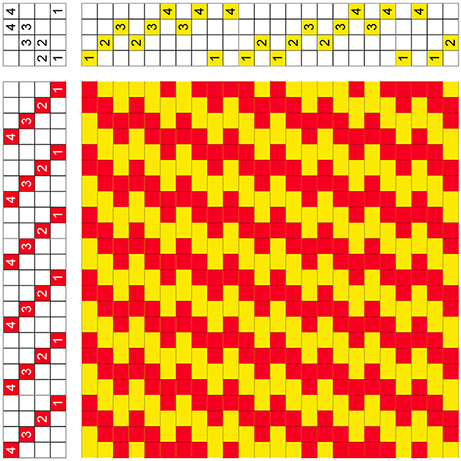
Next, we change the numbers to positions; note that the threading is not symmetrical, as the one in the example from the May blog:

We have our threading by numbering our shafts:

We slide the treadling to the right side and number the treadling steps:
 |
 |
Finally, we transpose the tie-up and then number the shafts attached to each treadle:
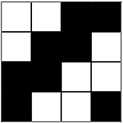 |
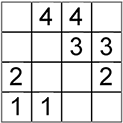 |
And here is our turned draft:
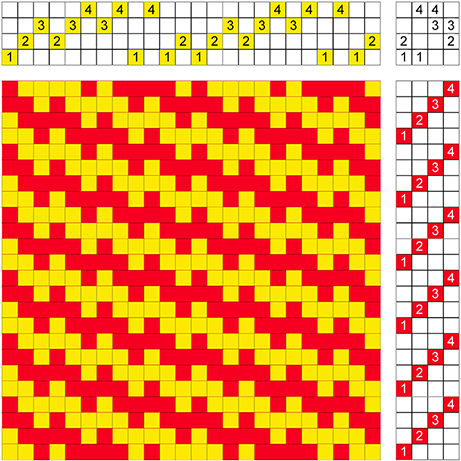
Click here for a draft that you can resize as needed
(a PDF will open a new window or in your list of downloaded files)
Below are the various combinations of starting the threading and the treadling from different positions. Some software that has the option of turning drafts uses algorithms that may return one of these options.
The advancing threading starting on the right reverses the direction of the twill on the loom:

Click here for a draft that you can resize as needed
(a PDF will open a new window or in your list of downloaded files)
Reversing of the direction of the twill also occurs if we keep the original threading but treadle starting on the left, 1, 2, 3, 4, rather than 4, 3, 2, 1, with the same tie-up.
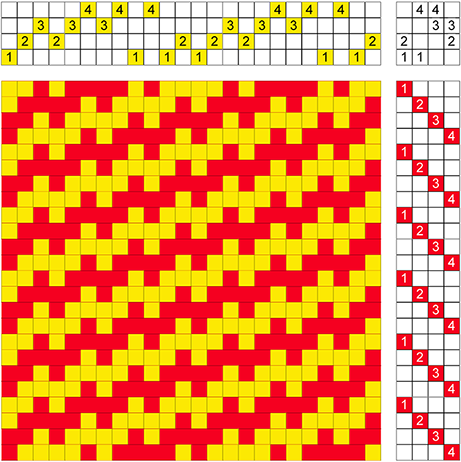
Click here for a draft that you can resize as needed
(a PDF will open a new window or in your list of downloaded files)
If we combine these two options – starting the threading on the right and the treadling on the left, we have the original turned drawdown. I would find this option easier to weave.
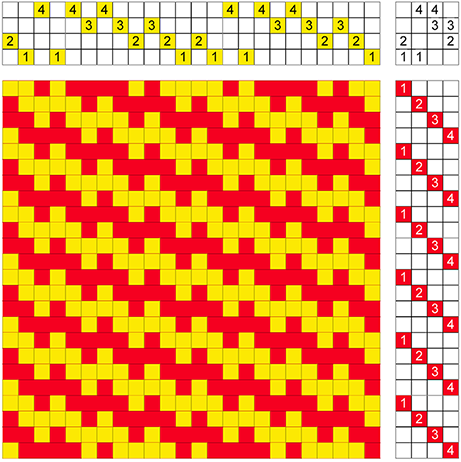
Click here for a draft that you can resize as needed
(a PDF will open a new window or in your list of downloaded files)
Challenge 2: Turning the Draft to Change a Two-shuttle Weave to a One-shuttle Weave
Many two-shuttle weaves have a complimentary weft and a ground weft that a weaves a plain weave background with the warp of the same size. This usually means 6 treadles, 2 for the ground, 4 for the pattern weft; in turning such a draft, there will be a threading with more than 4 shafts. Changing from two to one shuttle is used most with multi-shaft weaving.
Monk’s Belt, however, is a supplementary weft weave on 4 shafts, with 2 blocks and 4 treadles, so it can be turned on 4 shafts.
Below is the drawdown of Monk’s Belt; the grey warp and ground weft form plain weave in one block, while the other is covered with weft floats. The purple pattern weft weaves the two blocks. Thus there is one warp and two wefts.
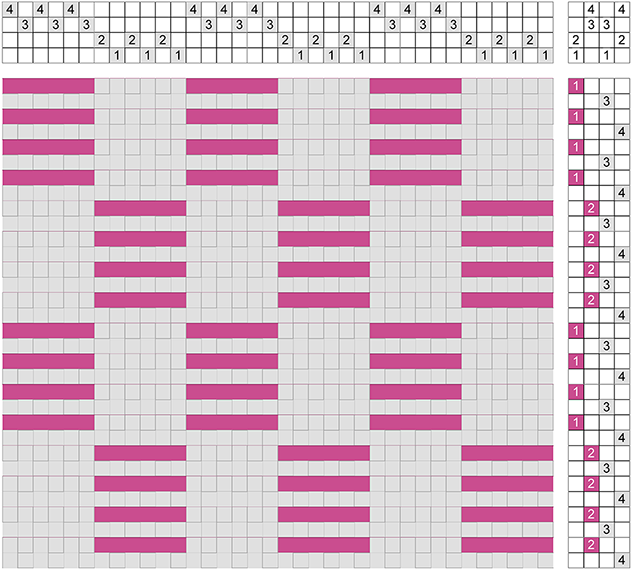
Click here for a draft that you can resize as needed
(a PDF will open a new window or in your list of downloaded files)
To turn the draft, we use the same method as shown in the sections above. Our end result will be two warps and one weft.
Here is the draft rotated with the numbers replaced by positions:

Then our threading is as rotated, the treadling slides to the right and the tie up slides to the right and is transposed; finally, positions are replaced by numbers and we can perform the drawdown, which is exactly like the original drawdown rotated:

Click here for a draft that you can resize as needed
(a PDF will open a new window or in your list of downloaded files)
And here is the fabric.
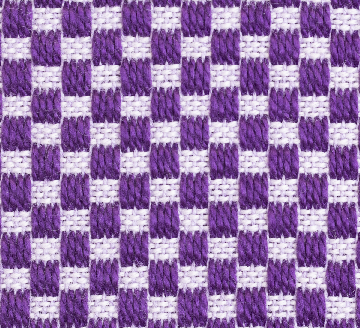
When I weave a supplementary weft weave, as Monk’s Belt, I set the warp for the ground tabby, but slightly more open. The same is true for a turned draft, which is, in fact, a supplementary warp weave. Barbara Walker, in her book Supplementary Warp Patterning says that the sett for a supplementary warp weave should be that of the ground warp, slightly more open to accommodate the supplementary warp.
In the sample above, the background warp and weft are 10/2 mercerized cotton. I set the warp at 18 epi which is the lower end of the tabby range. If I were using that yarn for plain weave without the supplementary warp, I would set it at 22 or 24, depending on the final use of the project.
Turning the draft this way can be used so that the supplementary warp forms stripes just in part of the cloth.
Challenge 3: Turning the Drafts with More Shafts
The process of turning a draft is the same, regardless of the original number of shafts.
Below is a draft of a summer and winter on 5 shafts, 3 blocks, treadled “singles” (each pattern shaft is followed by the same tabby shot), each block individually (meaning not combined). There are two repeats in the threading and two in the treadling. Since it has 8 treadles, the turned draft will require 8 shafts. In the draft below, the warp and background weft which form the tabby are in blue, the pattern weft in dark red.
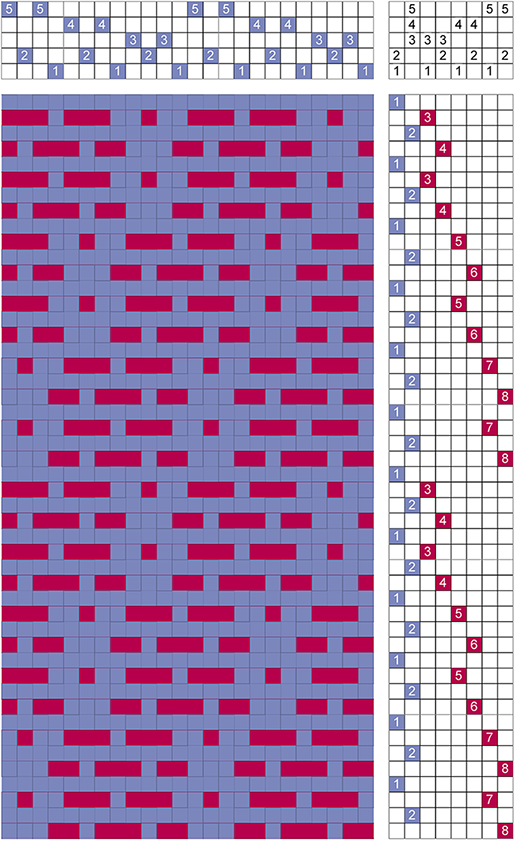
Click here for a draft that you can resize as needed
(a PDF will open a new window or in your list of downloaded files)
Below is the draft rotated, with numbers replaced by positions:

The treadling becomes the threading which has two warps, a background in blue and a pattern in dark red. The threading becomes the treadling and is moved over to the right. The tie-up is moved over to the right and transposed. Numbers replace the positions.
And the final draft:
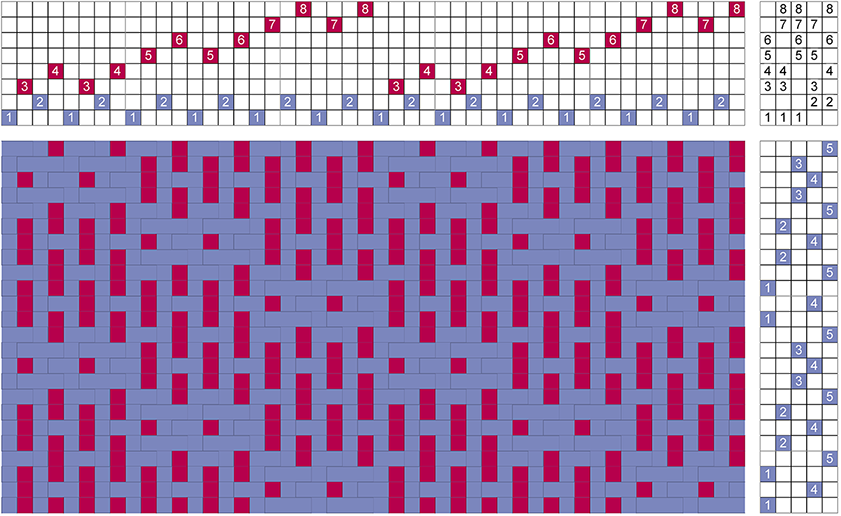
Click here for a draft that you can resize as needed
(a PDF will open a new window or in your list of downloaded files)
Here is a close up of the fabric. As in turned Monk’s Belt, the sett of the warp is that of the ground, slightly more open than the usually tabby to accommodate the supplementary warp.
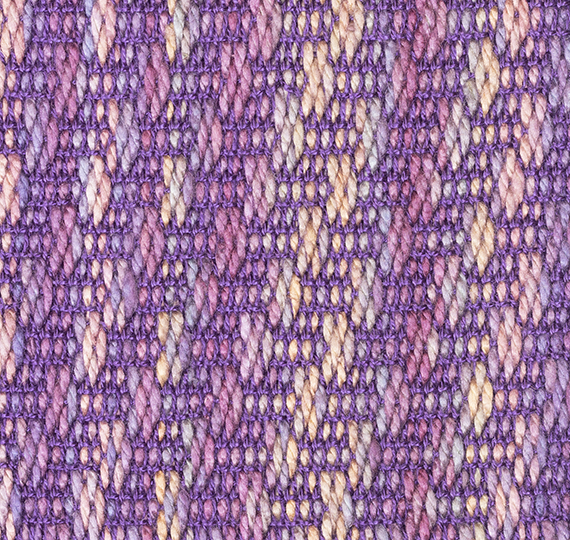
This is one method of turning drafts, probably the most common. I learned it when I was a fairly beginning weaver from Berta Frey’s book, Designing and Drafting for Handweavers. The terminology “transposing the tie-up” comes from her book (I did find an error in her tie-up in that section). Since then it has been discussed in other publications as well.
Some drawdown software offers the possibility of turning drafts by using algorithms that are not always applicable to all drafts. The method that I have described here, however, works with all kinds of structures.
Below is the full piece whose sample is above, which I wove from with the turned summer and winter draft we just discussed. It was supposed to be a sample, but I loved the colors, so I kept on weaving. It is too heavy for a scarf; it’s silk and narrow, so not appropriate for a table runner. I guess it’s going to be a wall hanging!

Happy Weaving!
Please email comments and questions to
